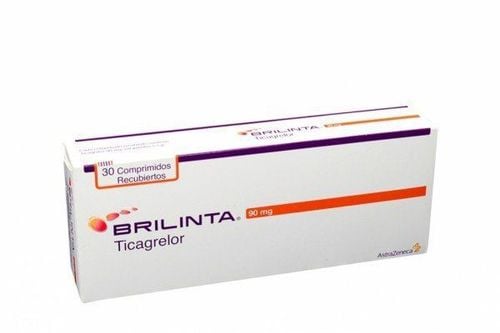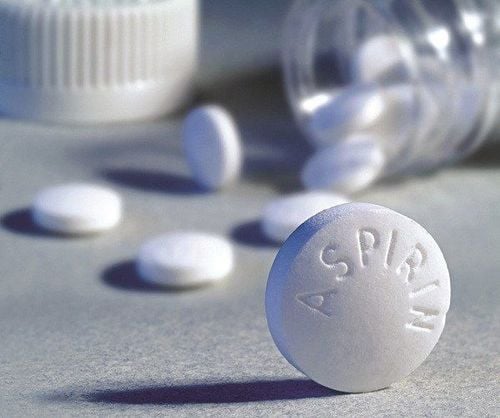This is an automatically translated article.
Cloplat belongs to the group of cardiovascular drugs. The drug is indicated for the treatment and prevention of diseases related to atherosclerosis. Let's learn about Cloplat to make sure it's safe and effective when used.
1. What is Cloplat?
Cloplat contains Clopidogrel bisulfate 75mg and other excipients just enough for 1 tablet. The drug is made in the form of film-coated tablets, packaged in a box of 3 blisters, each blister has 10 tablets.
2. What are the effects of Cloplat?
Cloplat is indicated for the treatment of the following cases:
Primary prevention of thromboembolic disorders such as myocardial infarction, stroke and peripheral arterial disease. Help control and prevent recurrence in atherosclerotic patients with recent stroke, myocardial infarction, or established peripheral artery disease. In addition, the drug Cloplat is contraindicated in the following cases:
Patients who are allergic to the active ingredient Clopidogrel bisulfate or other excipients contained in the drug's ingredients. The patient has bleeding in some locations such as stomach bleeding due to peptic ulcer or intracranial hemorrhage. The patient has severe liver failure.
3. Dosage and how to use Cloplat
Cloplat is a film-coated tablet that should be taken orally. The drug should be taken whole. Patients should not chew, crush or break the tablet before taking it.Because the drug is not affected by food, it can be taken before or after a meal without reducing the extent or speed of absorption.
Below is the dose of Cloplat drug:
Patients with a history of atherosclerosis: Use with a dose of 1 tablet (75mg), once a day. Dosage for patients with the purpose of preventing thromboembolic disorders such as myocardial infarction, peripheral artery disease and stroke is 1 tablet (75mg), taken once a day. Acute coronary syndrome (with typical symptoms of unstable angina or myocardial infarction without Q waves on electrocardiogram: Initial dose is 300 mg, administered once a day. When the critical period has passed, it can be used with a maintenance dose of 75mg per day.When using Cloplat for the elderly (over 65 years old) and renal failure, no dose adjustment is required. The above is only the recommended dose of the drug. The specific dose will be evaluated by the doctor based on the medical condition and health of each patient to determine the appropriate dose.
4. Side effects of Cloplat
Doctors always consider between the benefits that Cloplat brings to the patient and the possible risk of side effects to prescribe the appropriate medication.
Cloplat is well tolerated, some of the side effects that may be encountered when taking the drug include:
Common:
Gastrointestinal disturbances, diarrhea, abdominal pain, indigestion and nausea, skin allergies , erythema and pruritus. Uncommon:
Chest tightness, nosebleeds. Rare:
Upper gastrointestinal bleeding, peptic ulcer, severe neutropenia or agranulocytosis, thrombocytopenia, thrombocytopenic purpura, aplastic anemia, kidney disease such as nephritic syndrome, loss of taste, acute arthritis, ocular hemorrhage, and intracranial hemorrhage. Note: Some other side effects may occur when taking Cloplat medicine. However, not yet listed above. Therefore, patients should take the initiative to immediately inform their doctor or medical person if they suspect any side effects of Cloplat.
5. Cloplat drug interactions
When the following drugs are used in combination with Cloplat, there may be interactions, specifically:
When used in combination with Aspirin, there may be pharmacodynamic interactions leading to the risk of bleeding. Therefore, patients must be careful when using these two drugs together during treatment. However, both drugs can be combined for a period of up to 1 year. Similar to drugs such as Heparin, Warfarin: Risk of bleeding when used in combination with Cloplat. Therefore, caution should also be exercised when combining during treatment. For Non-Steroidal Anti-Inflammatory Drugs (NSAIDs): Study in healthy volunteers using naproxen. Concomitant use of Naproxen and Cloplat may increase the risk of potential gastrointestinal bleeding. Therefore, caution should be exercised when Cloplat is co-administered with non-steroidal anti-inflammatory drugs. Drugs Metabolized by the Cytochrome P450 System: At high concentrations in vitro, Cloplat has an inhibitory effect on Cytochrome P450. Therefore, this drug may affect the metabolism of drugs such as Phenytoin, Tamoxifen, Tolbutamide, Warfarin, Furosemide, Fluvastatin and many other non-steroidal anti-inflammatory agents. Co-administration of Cloplat with drugs capable of inhibiting CYP2C19 enzyme activity may result in decreased concentrations of the active metabolite of Cloplat. Therefore, caution should be exercised when co-administering CY2C19 inhibitors including Omeprazole, Esomeprazole, Fluvoxamine, Fluoxetine, Moclobemide, Voriconazole, Fluconazole, Ticlopidine, Ciprofloxacin, Cimetidine, Carbamazepine, Oxcarbazepine, Chloramphenicol. There may be interactions of Cloplat with food or other products not listed above. Therefore, stop using this medicine and seek medical attention as soon as any unusual reactions occur.
To avoid interactions, before being prescribed Cloplat, the patient should inform the doctor about the drugs they are using, including functional foods.
6. Notes when using Cloplat
Some notes when patients take Cloplat drugs are as follows:
Use caution when using Cloplat for patients with bleeding conditions due to trauma, surgery or other underlying medical conditions. In case the patient's condition requires surgery, the doctor needs to stop using Cloplat at least 5 days before the surgery. This drug should be used with caution in patients with suspected bleeding-related lesions such as in the case of gastrointestinal bleeding due to peptic ulcer. Care should be taken when administering drugs that can cause similar hemorrhagic lesions to patients receiving Cloplat. In patients with hepatic impairment or with metabolic disorders (such as poor metabolism due to CY2C19 deficiency), caution should be exercised when using Cloplat. Pregnant women: When using Cloplat, there may be potential risks to the fetus such as miscarriage, malformation,... Therefore, only use this drug when prescribed by a doctor. Lactation: The drug is known to be excreted in breast milk, so there is a risk of harm to the nursing infant when taking the drug. In case the mother has to take this medicine for the treatment, the patient can stop breastfeeding during the treatment period. Patients should not self-medicate without consulting a physician.
7. What to do in case of missed dose or overdose of Cloplat?
If you forget to take your medicine, take it as soon as you remember. The drug can be taken about 1-2 hours later than the daily dose. But when it is almost time for the next dose, the missed dose should be thrown away. Patients should absolutely not make up for a double dose. When taking an overdose, patients often experience symptoms such as nausea, vomiting, dizziness, gastrointestinal bleeding, convulsions, bleeding, shortness of breath, respiratory failure and tachycardia... In this case, the drug should be discontinued immediately and the treating physician informed. Family members should take the patient to the hospital for timely examination and treatment. Hopefully, the above article has provided all relevant information about the uses, dosage and some notes when using Cloplat. Patients need to take Cloplat exactly as directed by the doctor. Note, Cloplat is a prescription drug, patients can only use it when prescribed by a specialist.













